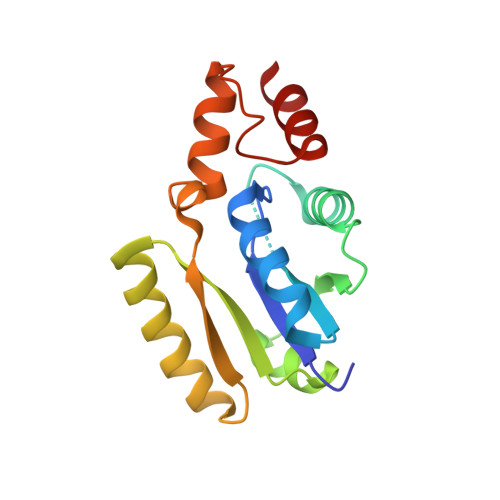Discovery of Inhibitors of 4'-Phosphopantetheine Adenylyltransferase (PPAT) To Validate PPAT as a Target for Antibacterial Therapy.
de Jonge, B.L., Walkup, G.K., Lahiri, S.D., Huynh, H., Neckermann, G., Utley, L., Nash, T.J., Brock, J., San Martin, M., Kutschke, A., Johnstone, M., Laganas, V., Hajec, L., Gu, R.F., Ni, H., Chen, B., Hutchings, K., Holt, E., McKinney, D., Gao, N., Livchak, S., Thresher, J.(2013) Antimicrob Agents Chemother 57: 6005-6015
- PubMed: 24041904
- DOI: https://doi.org/10.1128/AAC.01661-13
- Primary Citation of Related Structures:
4NAH, 4NAT, 4NAU - PubMed Abstract:
Inhibitors of 4'-phosphopantetheine adenylyltransferase (PPAT) were identified through high-throughput screening of the AstraZeneca compound library. One series, cycloalkyl pyrimidines, showed inhibition of PPAT isozymes from several species, with the most potent inhibition of enzymes from Gram-positive species. Mode-of-inhibition studies with Streptococcus pneumoniae and Staphylococcus aureus PPAT demonstrated representatives of this series to be reversible inhibitors competitive with phosphopantetheine and uncompetitive with ATP, binding to the enzyme-ATP complex. The potency of this series was optimized using structure-based design, and inhibition of cell growth of Gram-positive species was achieved. Mode-of-action studies, using generation of resistant mutants with targeted sequencing as well as constructs that overexpress PPAT, demonstrated that growth suppression was due to inhibition of PPAT. An effect on bacterial burden was demonstrated in mouse lung and thigh infection models, but further optimization of dosing requirements and compound properties is needed before these compounds can be considered for progress into clinical development. These studies validated PPAT as a novel target for antibacterial therapy.
Organizational Affiliation:
Infection Bioscience, AstraZeneca R&D Boston, Waltham, Massachusetts, USA.

















